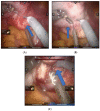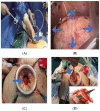Tips and Details for Successful Robotic Myomectomy: Single-Center Experience with the First 125 Cases
- PMID: 35683608
- PMCID: PMC9181482
- DOI: 10.3390/jcm11113221
Tips and Details for Successful Robotic Myomectomy: Single-Center Experience with the First 125 Cases
Abstract
With the continuous development of minimally invasive and precise surgical techniques, laparoscopic myomectomy has become a mainstream surgical method due to its aesthetic outcomes and rapid postoperative recovery. However, during laparoscopic myomectomy, clinicians often encounter unfavorable factors, such as limited vision, inaccurate suturing, difficulty in removing tumors, and susceptibility to fatigue in the operating position. In recent years, robot-assisted surgery has been widely used in gynecology. The advantages of this technique, such as a three-dimensional surgical view, reducing the surgeon's tremor, and the seven degrees of freedom of the robotic arms, compensate for the defects in laparoscopic surgery. The Department of Gynecology in our hospital has accumulated a wealth of experience since robot-assisted surgery was first carried out in 2017. In this article, the surgical skills of the robotic myomectomy process are described in detail.
Keywords: myomectomy; robot-assisted surgery; surgical tips and details.
Conflict of interest statement
The authors declare no conflict of interest. The funders had no role in the design of the study; in the collection, analyses, or interpretation of data; in the writing of the manuscript, or in the decision to publish the results.
Figures










Similar articles
-
Robot-assisted laparoscopic myomectomy: current status.Robot Surg. 2017 Jan 23;4:7-18. doi: 10.2147/RSRR.S102743. eCollection 2017. Robot Surg. 2017. PMID: 30697559 Free PMC article. Review.
-
Robotic-assisted minimally invasive surgery for gynecologic and urologic oncology: an evidence-based analysis.Ont Health Technol Assess Ser. 2010;10(27):1-118. Epub 2010 Dec 1. Ont Health Technol Assess Ser. 2010. PMID: 23074405 Free PMC article.
-
Robotic surgery in gynecology.J Minim Access Surg. 2015 Jan-Mar;11(1):50-9. doi: 10.4103/0972-9941.147690. J Minim Access Surg. 2015. PMID: 25598600 Free PMC article. Review.
-
[Robotic surgery in gynecology].Ginekol Pol. 2012 Dec;83(12):934-8. Ginekol Pol. 2012. PMID: 23488297 Review. Polish.
-
Robot-assisted single-incision laparoscopic myomectomy: initial report and technique.J Robot Surg. 2013 Jun;7(2):137-42. doi: 10.1007/s11701-012-0356-1. Epub 2012 May 31. J Robot Surg. 2013. PMID: 27000904
Cited by
-
Vaginal Myomectomy for Large Intracervical Fibroids in Women Desirous of Preserving Their Uterus: A Case Series.Cureus. 2025 Apr 22;17(4):e82788. doi: 10.7759/cureus.82788. eCollection 2025 Apr. Cureus. 2025. PMID: 40416286 Free PMC article.
-
Cervical fibroids: the vaginal intracapsular myomectomy with classification by the fibroids' origin, growth directions, and localizations.Front Med (Lausanne). 2025 May 9;12:1564667. doi: 10.3389/fmed.2025.1564667. eCollection 2025. Front Med (Lausanne). 2025. PMID: 40417667 Free PMC article.
References
LinkOut - more resources
Full Text Sources

